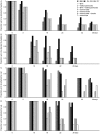Do induced responses mediate the ecological interactions between the specialist herbivores and phytopathogens of an alpine plant?
- PMID: 21573247
- PMCID: PMC3087800
- DOI: 10.1371/journal.pone.0019571
Do induced responses mediate the ecological interactions between the specialist herbivores and phytopathogens of an alpine plant?
Abstract
Plants are not passive victims of the myriad attackers that rely on them for nutrition. They have a suite of physical and chemical defences, and are even able to take advantage of the enemies of their enemies. These strategies are often only deployed upon attack, so may lead to indirect interactions between herbivores and phytopathogens. In this study we test for induced responses in wild populations of an alpine plant (Adenostyles alliariae) that possesses constitutive chemical defence (pyrrolizidine alkaloids) and specialist natural enemies (two species of leaf beetle, Oreina elongata and Oreina cacaliae, and the phytopathogenic rust Uromyces cacaliae). Plants were induced in the field using chemical elicitors of the jasmonic acid (JA) and salicylic acid (SA) pathways and monitored for one month under natural conditions. There was evidence for induced resistance, with lower probability and later incidence of attack by beetles in JA-induced plants and of rust infection in SA-induced plants. We also demonstrate ecological cross-effects, with reduced fungal attack following JA-induction, and a cost of SA-induction arising from increased beetle attack. As a result, there is the potential for negative indirect effects of the beetles on the rust, while in the field the positive indirect effect of the rust on the beetles appears to be over-ridden by direct effects on plant nutritional quality. Such interactions resulting from induced susceptibility and resistance must be considered if we are to exploit plant defences for crop protection using hormone elicitors or constitutive expression. More generally, the fact that induced defences are even found in species that possess constitutively-expressed chemical defence suggests that they may be ubiquitous in higher plants.
Conflict of interest statement
Figures


References
-
- Hatcher PE. Three-way interactions between plant-pathogenic fungi, herbivorous insects and their host plants. Biol Rev. 1995;70:639–694.
-
- Taylor JE, Hatcher PE, Paul ND. Crosstalk between plant responses to pathogens and herbivores: a view from the outside in. J Exp Bot. 2004;55:159–168. - PubMed
-
- Stout MJ, Thaler JS, Thomma B. Plant-mediated interactions between pathogenic microorganisms and herbivorous arthropods. Annu Rev Entomol. 2006;51:663–689. - PubMed
-
- Turlings TCJ, Wäckers FL. Cardé RT, Millar J, editors. Recruitment of predators and parasitoids by herbivore-damaged plants. Advances in Insect Chemical Ecology: Cambridge University Press. 2004. pp. 21–75.
-
- Wittstock U, Gershenzon J. Constitutive plant toxins and their role in defense against herbivores and pathogens. Curr Opin Plant Biol. 2002;5:300–307. - PubMed
Publication types
MeSH terms
LinkOut - more resources
Full Text Sources
Medical
Research Materials

